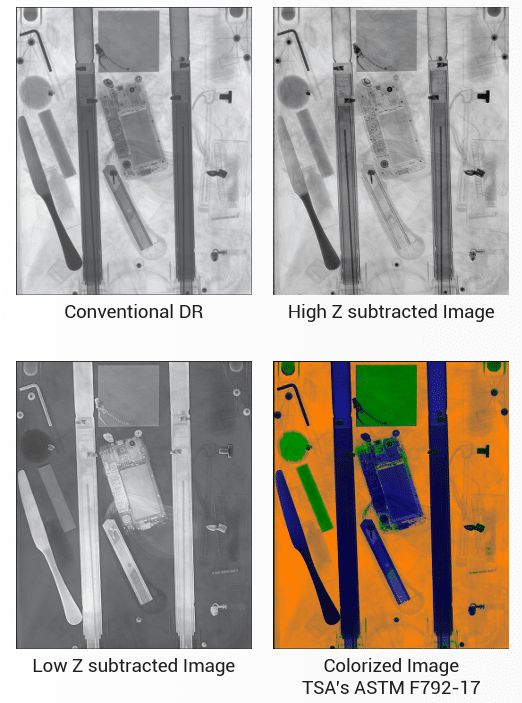
X-ray scanners play an important role in ensuring the safety of passengers coming in and out of the airport. CATSA utilizes X-ray technology to identify contraband such as weapons and explosives within a passenger’s luggage as well as on their person. This security check must be handled with precise accuracy, as it’s the only opportunity the airport has to stop contraband from ending up on the aircraft. Airport X-ray scanners are one of the most reliable tools for screening passengers and their luggage, as it can effectively detect objects that are purposely hidden by passengers. While ensuring safe travel for all, it’s vital that airports be mindful when selecting what X-ray scanner to use for their operations. From image resolution to material separation, we’ll uncover top features to prioritize in your choice of X-ray technology for airport security screening.
Dual Energy Technology
Passengers frequently conceal contraband in less obvious areas. That’s why dual energy X-ray technology is a must-have feature for airport security. In contrast to single energy X-rays, which have a hard time showing visual differentiation between materials, dual energy is designed to separate materials visually based on how they absorb or transmit X-rays. Thanks to this capability, dual energy X-ray can differentiate:
- High density materials
- Low density materials
Speeding up the airport security process is difficult to do because effectiveness must never be sacrificed in favour of efficiency. That being said, dual energy X-ray allows for faster workflows by making object identification more streamlined. Airport security personnel are able to immediately identify when an object is made of metal, plastic, organic, or inorganic material. This makes it easier to tell when an object on one’s person or within their luggage could be a threat.
Portable Dual-Energy: A Game Changer
Having dual-energy X-ray in a portable format brings a new level of flexibility to airport security. Instead of relying solely on fixed scanners, security teams can deploy Reveal wherever it’s needed—whether for random screenings, secondary inspections, or checkpoints with space constraints. This mobility ensures that advanced material differentiation is available beyond traditional screening lanes, enhancing threat detection across the airport.
Portability also means faster response times. Security personnel can bring Reveal directly to suspicious cargo or luggage, reducing the need to move items to a centralized scanner. This not only improves efficiency but also minimizes disruptions to airport operations, keeping passenger flow smooth while maintaining high security standards.
Reveal 35C is made with SpectralDR technology to enhance its material separation capabilities. It utilizes a compact three-layer design patented by KA, enabling it to produce images portably with up to 30% better image quality. Each layer ensures effective separation capabilities, producing three unique and distinctive images:
- A low density image, which captures materials like water, gas, or plastic, and objects like clothing, paper, or food.
- A high density image, which captures metal materials and objects like firearms, electronics, or coins.
- A traditional DR image, which combines low density and high density visualization.
Airport security personnel can view both the traditional DR, low density, and high density images to better identify each item in someone’s luggage. For example, if a metal object is pinpointed on the traditional DR image, security personnel can take a look at the high density image to identify what the object is with less visual clutter. The best part is it does not require more than one exposure in order to get three very different but useful images that visualize what’s inside.
High Resolution Imaging
X-ray image quality is critical for security screening. Reveal’s 140 µm pixel pitch delivers high-resolution imaging, enhancing object detection—even in densely packed cargo. Sharper images improve differentiation between materials, making it easier to spot prohibited items.
For smaller objects, like compact electronic devices, poor resolution can hinder detection. Reveal’s advanced imaging reduces reliance on manual searches and secondary checks, improving efficiency and cutting costs.
Fast Image Processing
It’s paramount in the airport that the X-ray scanner is capable of fast image processing. Airport security personnel must manage traffic through the airport and ensure optimal efficiency so each passenger reaches their flight on time. As such, it is simply impossible to utilize an X-ray that does not process images quickly.
With Reveal 35C, all three images produced via dual energy are created simultaneously and processed quickly upon the initial exposure. It can be used in portable applications as well as fixed. Despite creating three distinct images, it takes 30% less time to image using Reveal compared to standard X-ray. This quick access for dual-energy captures is revolutionary in the airline industry, empowering personnel with efficient identification and quick image processing.
Advanced Material Differentiation
Material differentiation is what allows airport security personnel to distinguish between harmless objects like clothing and dangerous objects that require intervention (such as firearms). Although every material absorbs X-rays differently, single energy X-ray produces visual similarities between different materials and items, making identification more difficult. These similarities happen because the energy level affects how the material absorbs X-rays. Metals, for example, absorb more X-rays at a lower energy because they have a higher atomic number. Dual energy is a solution to this, as it enables low and high energy X-rays to be absorbed at the same time.
Airport X-ray scanners with dual-energy capabilities and high contrast allow for the advanced material differentiation needed for luggage screening. Single energy X-rays have insufficient material differentiation and limit the security personnels’ ability to understand what is in a person’s luggage and if it could be dangerous.
KA Imaging’s SpectralDR technology is designed to separate materials instantaneously upon image capture. As previously mentioned, this advanced material separation allows the creation of three distinct X-ray images. It excels in metal and plastic separation, both of which are common materials found in passenger luggage.
ASTM F792222-17 Compliance
The ASTM F792222-17 standard, established by the Transportation Security Administration (TSA), sets guidelines for the performance and testing of X-ray screening systems used in airport security. The standard covers various aspects, including image quality, radiation safety, system performance, and testing procedures. Compliance with ASTM F792222-17 is crucial to ensure consistency and effectiveness in aviation security operations, safeguarding passengers, and air travel infrastructure against potential threats.
The Reveal 35C meets the rigorous standards of ASTM F792222-17, ensuring its dual-energy imaging capabilities align with industry benchmarks for security screening. Airport security personnel can take one look at the digital image and easily identify objects of interest based on colour.
Learn More about Reveal 35C
For more information on how the Reveal 35C can enhance your airport’s security protocols, contact us today! With the right tools in place, we can help ensure a safer flying experience for all passengers.
